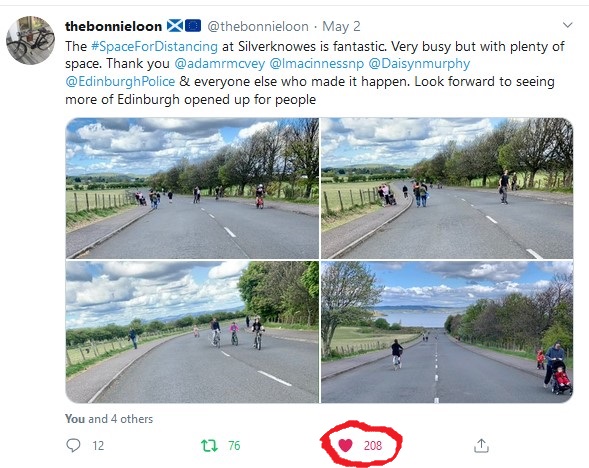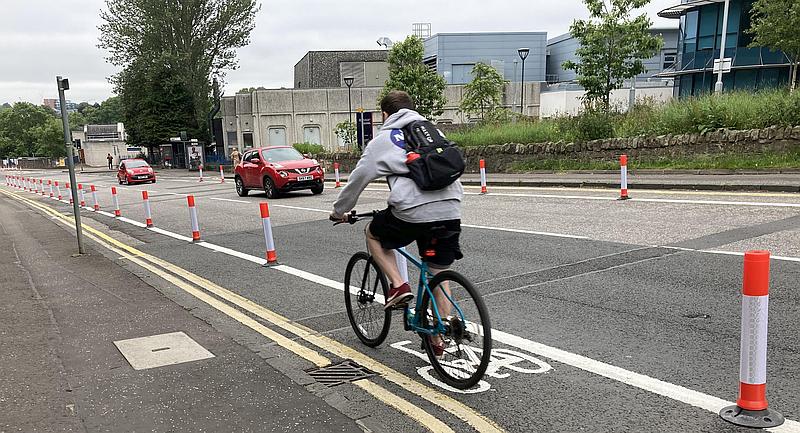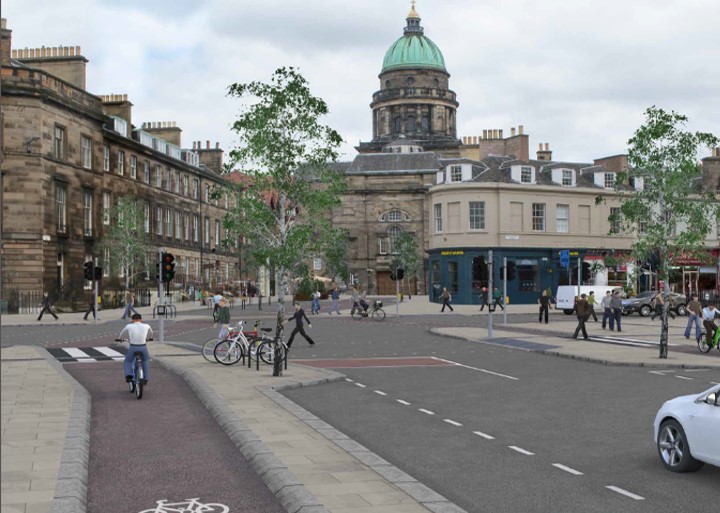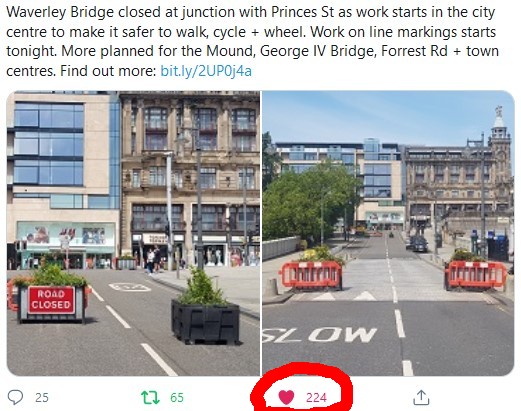Sept 2020 update – A revised and expanded version of this article is being presented at the Cycling and Society Annual Symposium, Sept 10-11, 2020.
In Scotland, the UK, and indeed around the world, measures to boost cycling and walking, and to restrict or tame motor traffic, are appearing in days or weeks on a ‘try then modify’ basis – rather than the years-long consultations to which councils and the public have become conditioned.
Many of them are very popular, with demands for more and sooner. And it’s not due to any radical new political or technical thinking – it’s all because of a virus!
Covid-19 means that Councils must maximise opportunities for social distancing, and for safe exercise and travel on foot and bike.
In Edinburgh, funded by the Sustrans and Scottish Government Spaces for People scheme, through-roads such as Silverknowes Road, Braid Road and Cammo Walk were closed – without consultation – within days of the new government Temporary Traffic Order change of regulations which permitted them. And they have generated wide support.

Of the five initial road closure schemes, two resulted in knock-on problems identified by local people – Council officers were quick to respond and make modifications. At the Braid Road closure the adjacent Braidburn Terrace was, within days, made one-way (with cycle exemption); whilst at Cammo Walk plans are underway urgently to install a light-controlled crossing of adjacent Maybury Road, to connect to Cammo Walk.
Under traditional thinking, few if any of these closures would have happened at all – and if they had it would have taken an absolute minimum of one year, likely much more, to consult, doubtless undertake ‘traffic modelling’ then be at the mercy of objections to any legally necessary traffic and/or redetermination orders. Instead, a virus and ‘try then modify’ worked their magic!
Mini-consultation
Although we think the Council originally intended all its Streets for People schemes to be ‘try then modify’ there was considerable unhappiness by some councillors, and so a compromise was reached. Schemes now undergo a strict 5-day consultation with relevant local councillors, community councils and a few city-wide ‘stakeholders’ such as Spokes and Living Streets. The Council promises still to be open to post-implementation modifications, or even removal, where problems arise.
This new mini-consultation arrangement has very strong arguments both for and against.
On the negative side, objections to schemes from some councillors and/or others may gain sufficient traction that the whole basis is reconsidered and the proposal effectively dropped. For example, on the north/south bus gates proposals, we see the possibility of the council reverting back to endless traffic modelling and what ‘might’ happen, rather than ‘try then modify.’
On the positive side, Spokes (and others), whilst hugely delighted with most of the proposals, have identified a few very significant yet easily-remedied problems or omissions. For example, the initial Crewe Road South cycle lane to the Western General Hospital was to be unsegregated, but the consultation reversed this before installation.
There are two other examples where consultation has enabled us to make crucial advance comments – though at the time of writing, we don’t know the outcomes. First, the Princes Street plans would have lengthened the stretch of very narrow roadway between kerb and tramline leading up to a tramline crossing which already sees regular cyclist crashes and injuries and is the site of long-overdue council mitigation plans. Second, the opportunity for an uphill cycle lane to the top of Leith Street was not grasped, despite removal of one of the two traffic lanes and despite recognition of its “absolute” importance by the Director of Place at the 25.1.18 Transport and Environment Committee [Spokes 130 p1].

Spaces for People – Edinburgh & Scotland
For more information on schemes now in place, and others planned soon, see…
- Edinburgh schemes – Council info
- Edinburgh schemes – Spokes info
- All Scotland – Pedal on Parliament info
- How Spaces for People works – Sustrans Scotland info
Many people, ourselves included, are frustrated that progress is not faster, especially when we look to what is happening in many cities around the world, including Paris and London. However, different countries have different regulations as to what councils can do and how they can do it. Scottish Councils risked legal challenges until the Scottish Government made changes to the rules allowing Temporary Traffic Regulation Orders for covid-related traffic schemes.
Edinburgh at least looks like it is moving more and faster than any other Scottish Council on these emergency measures (perhaps Glasgow is on a par). It is also encouraging that Edinburgh – and a good number of other councils – seem intent on continuing implementation of Streets for People measures despite the fact that cars are returning, and that driver complaints may therefore rise.
It is of course important to note that all these schemes are covid-related and ‘temporary’ – but Edinburgh Council and the Scottish Government have both expressed the hope and intention that as many as possible will become permanent if successful.
The Scottish Government really has to change the rules on Traffic Orders to make this feasible without inordinate delays and wasting of staff time because of the way in which certain types of objection have to be treated [see below].
Maxi-consultation
In contrast to these covid schemes, traditional consultation approaches often take many years – and there is no guarantee anything will appear on the ground at all. None of the following examples are yet in place …
- Canal to Meadows – still accepted by the Council as an important missing link – on the go since at least 2013, with several consultations and plan revisions over the years, plus serious problems with staff leaving and staff cuts
- CCWEL City Centre west-east link – the Council’s ‘flagship’ route – on the go since at least 2015. Delayed by multiple consultations, experienced staff leaving and the Traffic Orders labyrinth (below).
- Meadows to George Street – As far as we know, everything here has gone according to plan – yet funding was obtained in 2017 and construction is not planned to begin until 2022! There were initial council proposals, then a consultation on ‘principles,’ then on a ‘concept design’ – and now we await further consultation on detailed design and traffic regulation orders.
- George Street – this is perhaps the worst example. After 10 years, we still seem little closer to a final design, let alone implementation
- 2010 Jan Gehl report on Edinburgh City Centre [see para 1102 here] recommends major change.
- 2013 Public consultation on city centre – Council unable to agree on widespread major change; and decides instead to focus on George Street, with an 18-month experiment (with cycle lanes)
- 2014 Consultation on the Experimental Traffic Regulation Order (ETRO).
- 2014/5 Extensive consultation during the experiment but an ETRO legally cannot be extended, so…
- 2015 George Street reverts to old layout
- 2016 Consultants produce ‘design principles‘ based on the above
- 2017 Consultants report on George Street ‘Public Life’
- 2018 More consultants, consult on ‘draft concept design‘
- 2019 Council approves ‘design elements’ for George St, but more consultation needed. Application to Sustrans for further design work and “towards future delivery.” Application succeeds
- 2019 Stakeholder consultation on ‘unresolved issues.’ Much of project still at “high level” stage. Little clarity on cycleroute design or guaranteeing it will be suitable standard as part of CCWEL cross-city route
Whilst such delays have caused considerable frustration, there has almost been a resigned acceptance that it is inevitable. This, incidentally, is a UK-wide issue, not just Edinburgh. Covid Spaces for People shows that such timescales are in fact ludicrous – and, literally for years, they deprive thousands of citizens of safe and welcoming cycling conditions for which the cash and basic concepts are in place.

Traffic Regulation Orders
The Scottish Government’s Traffic Regulation Order (TRO) and Redetermination Order (RSO) labyrinth is one of the several reasons for big delays. For example…
- Whilst there have been many reasons for the 6+ years of the CCWEL process (see above) at least 18 months (still ongoing) were due to tortuous and inconsistent Scottish Government rules which require certain types of objections to be referred to the Scottish Government for decision and a possible public inquiry. The CCWEL delay resulted from a small number of TRO objections (all eventually dismissed by the government Reporter) and RSO objections (no decision yet by ScotGovt). In contrast, when over 150 people and organisations, including Community Councils, objected to a TRO cutting bus lane hours, the TRO rules allowed the Council to dismiss them without any inquiry. [Technically, as we understand it, any unwithdrawn TRO objection affecting loading; or any unwithdrawn RSO objection, cannot be decided by the Council and have to be referred to the government, whereas other types of objection can be decided locally].
- A Council cannot extend an Experimental Traffic Regulation Order – and the results of the experiment are unlikely to be known in time to make the scheme permanent before it has to be removed. In the George Street case (above) the experimental scheme therefore had to be removed rather than staying until a permanent scheme was agreed – even though it was widely thought to better than the original layout.
Summary of delay causes
The excessive time taken to implement some of Edinburgh’s active travel projects has 3 main causes…
- Extensive consultations at multiple stages of projects – this is probably the top reason. Consultation is important, but it has grown and grown. It sounds ‘a good thing’ – and there are plenty consultants out there to tout it (and benefit from it!) However, it is worth remembering that no one was consulted over the gradual process by which quiet streets where children played and people walked and cycled morphed into congested, polluted roads where no one plays, people are scared to cycle, and walking is no longer a pleasure.
- The Scottish Government’s Traffic Regulation Order labyrinth – the government has agreed to a lengthy review (over a year so far) and also amended the 2019 Transport Bill so that it can now change TRO/RSO rules without a further Act of Parliament, if and when it decides to do so. Now, thanks to covid19, the government did rapidly introduce new rules giving councils powers to introduce ‘temporary’ TROs for purposes related to covid issues – but the problems with the standard permanent Orders remain in limbo.
- Staffing – cutbacks and/or staff turnover – experts, or those leading active travel projects, leaving and being hard to replace (consultancies often pay higher wages). When projects are implemented rapidly, then obviously they are less likely to encounter such episodes of staff disruption.
Consultation revolution?
The Covid crisis has shown what is possible. Can we learn from it, and combine realistic levels of consultation with ‘try then modify’ – and thereby ensure that projects actually get implemented – and in sensible timescales?
Perhaps something like this…
Small project (such as a road closure)
- Consult local residents & stakeholders on a proposed design, and modify design as appropriate
- Install using temporary/cheap materials, with an experimental or temporary traffic order (assuming Scottish Government amends the rules appropriately)
- If necessary, based on feedback, modify the experiment
- Once the scheme works well, make a permanent Order and then install in permanent form
Major project (such as Meadows to George Street)
- Using stakeholder consultation only, work up 2 or 3 options in reasonable detail
- Major public consultation on these options
- Install best option using temporary/cheap materials, with an experimental or temporary traffic order (assuming Scottish Government amends the rules appropriately)
- If necessary, based on feedback, modify the experiment
- Once the scheme works well, make a permanent Order and then install in permanent form
Such scenarios, we hope, would …
- in most cases, provide the public with many of the benefits of the final scheme far earlier, through the experimental scheme
- ensure more realistic feedback, by experiment, than by purely paper, computer modelling and public opinion exercises
- ensure that all affected people are aware of the project (because they experience the experimental scheme!) and so have an opportunity to comment – at present many people are unaware of paper or online consultations
- identify problems at a stage when they can be remedied/tested cheaply rather than after a costly ‘final’ implementation
- in most cases result in the permanent solution being in place far earlier
- save significant amounts of government and council cash.
Do you agree? If so…
- Ask your MSPs to get the Traffic Order rules changed rapidly
- Ask your councillors to discuss and agree new faster and hopefully more effective procedures, as we suggest above, for all new ‘permanent’ projects. This should be decided soon, not waiting till the covid19 pandemic is over, and should apply to all existing non-covid ‘permanent’ projects, as well as future projects
- Retweet our tweet about this article.


[…] a post (here), published on the 25th of last month by Lothian cycle campaign, Spokes, there is dismay that what […]